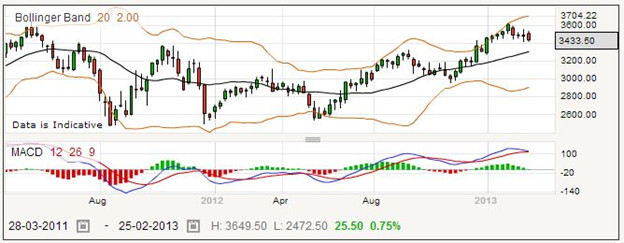Oracle Corporation Fundamentals
Oracle Corporation is a US multinational computer company headquartered in California. You can see from the weekly price chart below that it has excellent movement for futures style spread betting, where you may hold the position open for several weeks or months.
The company was originally founded in 1977, and has long had database software as one of its core products. In fact it had been called Software Development Laboratories and later Relational Software before changing its name in 1982 to Oracle Systems Corporation in recognition of its main product Oracle Database.
With good foresight, the database had been written in the C programming language from 1983, and the portability this gave across different systems made it a strong competitor to IBM’s database software. The marketplace has proved to be competitive, with SAP a long-running rival.
Oracle has other areas of interest, including business software, and computer hardware which it added by acquiring Sun Microsystems in 2010 in a deal valued at more than $7 billion. Later the same year the US Department of Justice sued Oracle Corporation for fraud, with the result that currently Oracle is not allowed to bid on federal contracts.
Oracle is ranked as the third largest software maker by revenue, only behind IBM and Microsoft, which shows the extent of acceptance of its software solutions, which include customer relationship management software and supply chain management software. Controversy has plagued Oracle over the years, due in part to the fiercely competitive business sector in which it operates.
The price chart above shows many trends which last for several weeks or months, and the candlesticks are a reasonable length, meaning that there is good volatility for the astute trader. On the scale presented, the MACD appears to be giving a good representation of the trends, suggesting that the price will respond to detailed analysis.
Oracle Corporation Rolling Daily
The current quotation for a rolling daily bet on Oracle Corporation is 3423 – 3430. Oracle shows reasonable volatility, and your trading strategy suggests the price will fall. Imagine you place a sell bet at the selling price of 3423 with a stake of £5 per point.
After a few days, if it works out you might find the price falling to 3253 – 3260, and decide to close your spread bet and collect your winnings. As it was a short bet, it closes at the buying price of 3260. That means you have gained the difference between 3423 and 3260, which is 163 points. You chose to stake £5 per point, so this multiplies out to a gain of £815.
If the price goes up instead of down, you must make a decision to close the trade and accept your loss, rather than letting it drag on and become larger. Say you decide to close when the price rises to 3508 – 3515. The starting price was 3423, as before. You close the trade when the buying price was 3515. Taking 3423 away from 3515, you would have lost 92 points. With £5 stake, that amounts to a loss of £460.
A stop loss order accomplishes two things. It saves you keeping an eye on the price, as your spread betting provider will automatically close the trade when it reaches the price level you set. And it also saves you having to make a decision to close the trade, when the temptation is to wait and see if the price comes back. In this case, a stop loss order could have closed the short trade when the price went up to 3474 – 3481. Taking the starting price of 3423 away from the closing price of 3481, this time you would have lost 58 points, which would amount to a loss of £290.
Oracle Corporation Quarterly Futures
As mentioned previously, the Oracle Corporation has exhibited price behaviour that would favour holding a spread bet open for several weeks or months. Therefore you might consider placing a quarterly futures bet. The current quote for the far quarter is 3423 – 3457. Say you predict a bullish outlook for the stock, you might choose to place a long bet with a stake of £3.50 per point.
Consider first the case when the bet works out for you. The price may go up to 3678 – 3712, and you decide to collect your profits. You close the bet at the selling price of 3678. Taking away the opening price of 3457, you have made a total of 221 points. Multiplying this by £3.50, your winnings amount to £773.50.
Now look at the losing scenario. If the price fell to 3338 – 3372, you could close your spread bet and cut your losses. The opening price was 3457, and the closing price is 3338. That means you lost the difference, 119 points. At £3.50 per point, this works out to £416.50.
A lot of spread traders use a stoploss order to watch the market for them. The stoploss order requires your spread betting provider to close your trade if it reaches a certain level of loss, and saves you the effort of following the market. While you should always keep in touch with your spread bets, it is just not possible to pay such close attention to the price as your spread betting company can. In this case, suppose that a stoploss order closed the losing spread bet at 3372 – 3406. Taking the closing price of 3372 away from the opening price of 3457, you would be facing a loss of 85 points. £3.50 times 85 works out to a total loss of £297.50.



Join the discussion